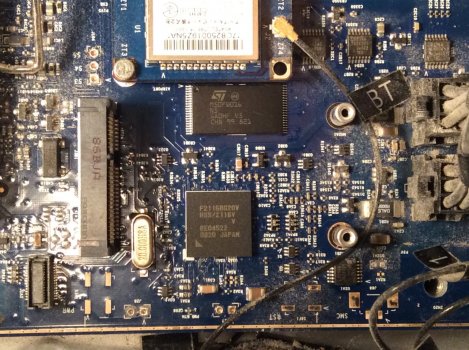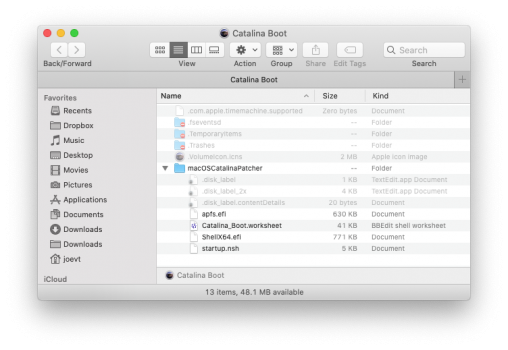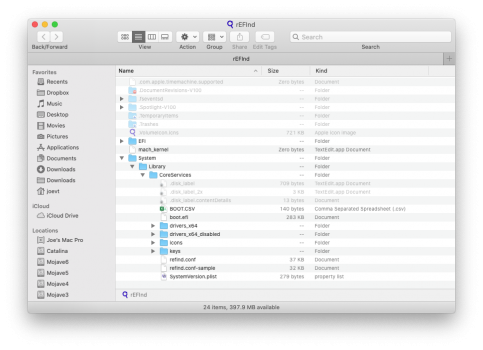BootCurrent: Boot0000
BootNext:
BootOrder: Boot0080
Boot0080: 1, "Mac OS X", "PciRoot(0x0)/Pci(0x1F,0x2)/Sata(0x1,0x0,0x0)/HD(1,GPT,97CD1709-FE99-4E1F-BF41-75D379A46CC4,0x28,0x64000)/\EFI\BOOT\bootx64.efi"
Searching: Boot0000
Searching: Boot007F
Searching: Boot0081
Boot0081: 1, "Mac OS X", "PciRoot(0x0)/Pci(0x1F,0x2)/Sata(0x2,0x0,0x0)/HD(10,GPT,977D4C1D-54CA-4594-B9F6-FCABF87AC36C,0x4B405D88,0x174876E8)/VenMedia(BE74FCF7-0B7C-49F3-9147-01F4042E6842,7E98A08505BD8940A1199C16AA7CD67D)/\10D5CE8C-43FE-43F2-8089-DAEDF6485644\System\Library\CoreServices\boot.efi"
Searching: BootFFFF
BootFFFF: 1, "", "PciRoot(0x0)/Pci(0x1F,0x2)/Sata(0x2,0x0,0x0)/HD(9,GPT,717720E1-2443-443E-B26D-D85098BC319E,0x2E34C888,0x1D0B9500)/VenMedia(BE74FCF7-0B7C-49F3-9147-01F4042E6842,9494DC23508D8540A389493878A2404B)/\System\Library\CoreServices\boot.efi"
DriverOrder: Driver0080
Driver0080: 1, "apfs.efi", "PciRoot(0x0)/Pci(0x1F,0x2)/Sata(0x1,0x0,0x0)/HD(1,GPT,97CD1709-FE99-4E1F-BF41-75D379A46CC4,0x28,0x64000)/\drivers\apfs.efi"
Searching: Driver0000
Searching: Driver007F
Searching: Driver0081
Driver0081: 1, "FakeUEFI2.efi", "PciRoot(0x0)/Pci(0x1F,0x2)/Sata(0x1,0x0,0x0)/HD(1,GPT,97CD1709-FE99-4E1F-BF41-75D379A46CC4,0x28,0x64000)/\drivers\FakeUEFI2.efi"
Driver0082: 1, "nv_gop_GF10x", "PciRoot(0x0)/Pci(0x1F,0x2)/Sata(0x1,0x0,0x0)/HD(1,GPT,97CD1709-FE99-4E1F-BF41-75D379A46CC4,0x28,0x64000)/\efis\nv_gop_GF10x.efi"
Driver0083: 1, "ReloadPCIRom.efi", "PciRoot(0x0)/Pci(0x1F,0x2)/Sata(0x1,0x0,0x0)/HD(1,GPT,97CD1709-FE99-4E1F-BF41-75D379A46CC4,0x28,0x64000)/\drivers\ReloadPCIRom.efi"
Driver0084: 1, "UgaOnGop.efi", "PciRoot(0x0)/Pci(0x1F,0x2)/Sata(0x1,0x0,0x0)/HD(1,GPT,97CD1709-FE99-4E1F-BF41-75D379A46CC4,0x28,0x64000)/\drivers\UgaOnGop.efi"
Driver0085: 1, "CrScreenshotDxe.efi", "PciRoot(0x0)/Pci(0x1F,0x2)/Sata(0x1,0x0,0x0)/HD(1,GPT,97CD1709-FE99-4E1F-BF41-75D379A46CC4,0x28,0x64000)/\drivers\CrScreenshotDxe.efi"
Searching: DriverFFFF




